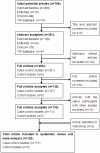Association between alcohol consumption and cancers in the Chinese population--a systematic review and meta-analysis
- PMID: 21526212
- PMCID: PMC3078147
- DOI: 10.1371/journal.pone.0018776
Association between alcohol consumption and cancers in the Chinese population--a systematic review and meta-analysis
Abstract
Background: Alcohol consumption is increasing worldwide and is associated with numerous cancers. This systematic review examined the role of alcohol in the incidence of cancer in the Chinese population.
Methods: Medline/PubMed, EMBASE, CNKI and VIP were searched to identify relevant studies. Cohort and case-control studies on the effect of alcohol use on cancers in Chinese were included. Study quality was evaluated using the Newcastle-Ottawa Scale. Data were independently abstracted by two reviewers. Odds ratios (OR) or relative risks (RR) were pooled using RevMan 5.0. Heterogeneity was evaluated using the Q test and I-squared statistic. P<.01 was considered statistically significant.
Results: Pooled results from cohort studies indicated that alcohol consumption was not associated with gastric cancer, esophageal cancers (EC) or lung cancer. Meta-analysis of case-control studies showed that alcohol consumption was a significant risk factor for five cancers; the pooled ORs were 1.79 (99% CI, 1.47-2.17) EC, 1.40 (99% CI, 1.19-1.64) gastric cancer, 1.56 (99% CI, 1.16-2.09) hepatocellular carcinoma, 1.21 (99% CI, 1.00-1.46) nasopharyngeal cancer and 1.71 (99% CI, 1.20-2.44) oral cancer. Pooled ORs of the case-control studies showed that alcohol consumption was protective for female breast cancer and gallbladder cancer: OR 0.76 (99% CI, 0.60-0.97) and 0.70 (99% CI, 0.49-1.00) respectively. There was no significant correlation between alcohol consumption and lung cancer, colorectal cancer, pancreatic cancer, cancer of the ampulla of Vater, prostate cancer or extrahepatic cholangiocarcinoma. Combined results of case-control and cohort studies showed that alcohol consumption was associated with 1.78- and 1.40-fold higher risks of EC and gastric cancer but was not significantly associated with lung cancer.
Conclusions: Health programs focused on limiting alcohol intake may be important for cancer control in China. Further studies are needed to examine the interaction between alcohol consumption and other risk factors for cancers in Chinese and other populations.
Conflict of interest statement
Figures




References
-
- World Health Organization. Global status report on alcohol. Geneva: World Health Organization; 1999.
-
- Ma GS, Du SM, Hao LN, Li YP, Hu XQ, et al. The prevalence of heavy drinking among adults in China. Acta Nutrimenta Sinica. 2009;3:213–217.
-
- Health drinking activity committee. Survey on alcohol drinking and health of Chinese people in 2007. 2007
-
- World health organization. International Guide for Monitoring Alcohol Consumption and Related Harm. 2000. Geneva. Available: http://whqlibdoc.who.int/HQ/2000/WHO_MSD_MSB_00.4.pdf. [Accessed 30 March 2010.]
-
- Chinese nutrition society. Dietary Guidelines for Chinese People. 2007 ed. Lhasa: Tibet Peoples Publishing press; 2008. pp. 90–95.
Publication types
MeSH terms
LinkOut - more resources
Full Text Sources
Medical

